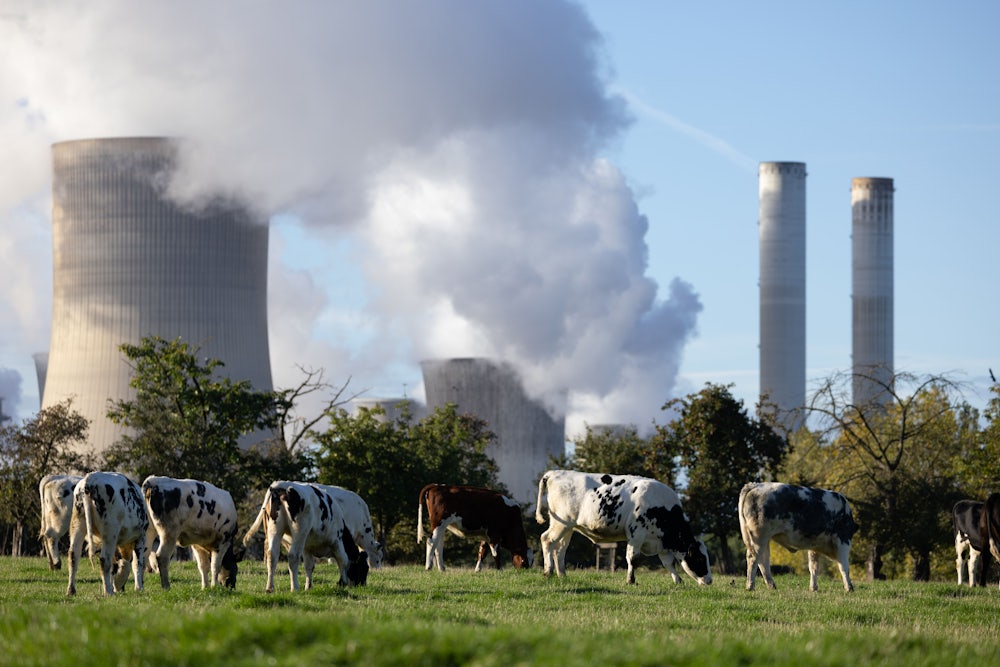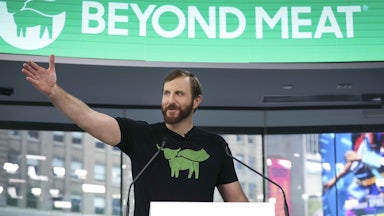A key goal of climate policy is to regulate and eventually phase out polluting infrastructure, like coal-fired power plants, and replace dirty machines, like gas-powered cars, with cleaner alternatives. Dozens of nations have pledged to stop burning coal for power, while the EU and several U.S. states will effectively ban the sale of combustion engine cars in the mid-2030s.
In the agricultural sector, though, governments are not phasing out the polluting machines or the infrastructure that keeps belching out emissions. They are not phasing out cows and pigs, or demanding farms close down.
Unlike their metal counterparts, livestock are sentient. Cows can feel pain when hot iron brands their skin or feel scared when their children are taken away from their breast. Yet these biological machines were partially designed for human needs (through selective breeding and genetic modification) and convert less useful inputs— like soybeans—into more useful ones, like delicious bacon cheeseburgers. The vast majority of the approximately 10 billion animals slaughtered in the USA each year are not living decent lives as animals but being fattened in confined spaces under horrendous conditions that do extreme damage to local environments.
For now, nearly all governments around the world seem intent to increase the number of these machines and the infrastructure that creates them. About a third of global public agricultural subsidies, which totaled $233 billion in 2017, are for the production of meat, milk, or dairy—even though the livestock that feeds us is also responsible for around 15 percent of global greenhouse gas emissions. In the United States, labor and environmental scholars speak of “agricultural exceptionalism” due to the sector’s exemption from most environmental regulations. In other words, governments are decidedly not trying to take away your burgers, despite the claims of some U.S. conservatives.
But a rare few policymakers in countries around the world are taking some steps to curb the numbers of livestock. And by looking at these exceptions to the trend, we can understand what it would look like if governments made a real effort to stop people bringing home quite as much bacon.
There aren’t many governments working to explicitly downsize the number of animal machines as part of their climate plans. Three small European countries—Ireland, Belgium, and the Netherlands—are working to directly reduce their livestock numbers for climate reasons. Ireland has a controversial draft proposal to pay farmers 3,000 euros ($3,144) for each dairy cow they cull. With more cattle than people, Ireland has the highest methane emissions per capita in the EU, and the agriculture ministry feels that getting rid of some cows is the only way to achieve climate targets.
Over in the Flanders region of Belgium, the government is using a mix of voluntary and mandatory measures to reduce pig numbers. It worked with farmers’ associations to create a 200 million euro fund to buy out pig farmers. But it’s also put dozens of farms and manure-processing plants on a “red list,” which will force them to cease their activities. It’s reminiscent of how countries like Germany have been compensating owners of coal-fired power plants for shutting down their polluting infrastructure.
The most dramatic conflict over livestock numbers is unfolding in the Netherlands, whose government has a stated goal of cutting livestock numbers by one-third by 2030. Vast quantities of animal manure have been polluting Dutch air and water and releasing nitrous oxide, a potent greenhouse gas. Ever since a 2019 court ruling ended exemptions for ammonia pollution from farms, the government has been writing checks and giving orders to reduce the number of pigs.
These countries are exceptional in these approaches: Most countries simply set targets for emissions from agriculture and leave it up to farmers to figure out how to stay within the rules. When governmental bodies do spell out that stated climate commitments “necessarily call for a significant reduction in livestock,” as the French court of auditors said in May, it tends to alarm the agricultural industry. So do punitive measures like New Zealand’s plan to require farmers to start paying a price for the methane that cows belch and the nitrous oxide that comes from their urine.
Another group of policies doesn’t deal with greenhouse gas emissions but rather targets other negative outcomes of livestock farming, like antimicrobial resistance. About 80 percent of antibiotics sold in the U.S. are for animal agriculture; these drugs allow for higher productivity by reducing the risk that animals will get sick when they are kept in close confinement. But their overuse in livestock raises risks of deadly antibiotic-resistant infections in humans. A new Food and Drug Administration rule that went into effect this summer requires U.S. ranchers to get prescriptions for the antibiotics they feed to livestock, which will hopefully cut down on their excessive use.
Then there are animal welfare regulations, like California’s new law that requires pigs to be kept in enclosures of at least 24 square feet, which will make it more expensive to house them. Higher costs for farmers means higher costs for bacon in the supermarket—which could reduce demand. Similarly, an incoming EU law to ban the import of beef linked to deforestation might reduce the number of cows owned by ranchers in the Amazon. Finally, there are more and more restrictions on water use and on grazing on public lands in the drought-stricken American West, both of which can make it too expensive for ranchers to keep raising their biological machines.
Just as policymakers around the world are helping speed the shift to electric vehicles with consumer incentives, governments are also beginning to push less polluting substitutes to animal agriculture. Public funding for alternative proteins, such as oat milk and burgers made of pea protein, topped $600 million globally in 2022. Governments are also aiding the development of meat grown from cell cultures in bioreactors, or egg and dairy products made via fermentation. Cell-cultured chicken is now available to purchase in the U.S., Singapore, and Israel.
The gentlest option for reducing livestock numbers is to give consumers more information about their animal products and the potential benefits of eating other proteins, allowing them to drive down demand on the market. The U.S. does this in its dietary guidelines, and Germany’s new labeling system tells customers how an animal lived prior to slaughter. China’s government describes “future foods” like plant-based eggs and cultivated meat as important tools for food security in its latest five-year plan for agriculture.
This might sound like an overwhelming array of policies—but again, these efforts are exceptions. The thrust of most government policy is to enable people to eat more meat. Leading policymakers like U.S. Agriculture Secretary Tom Vilsack tend to reject restraints on meat consumption, overhyping tweaks that might reduce pollution but keep the polluting machines around. Rather than considering phasing out these polluting machines, policymakers overwhelmingly get behind livestock feed additives that may reduce how much methane cows belch into the atmosphere, or digesters that turn cow manure into biofuels and create extra revenue for the owners of polluting infrastructure—much like the process of carbon capture does on a power plant.
There are some good reasons why most policymakers have concrete plans to phase out coal power plants but take only occasional, haphazard steps to limit the growth in the number of farmed animals. Meat, milk, and eggs can be an important source of protein and nutrients. Increasing access to animal products can change lives and livelihoods in poorer countries like Burundi, where the average person eats less than seven pounds of meat per year, compared to nearly 300 pounds a year in Hong Kong or the USA. While it’s hard to quantify animal products’ cultural or gustatory value, it is clear that replacing a slice of hot pepperoni pizza with tofu is not as straightforward as changing the source of the invisible electrons that flow through a wall socket. Even in a best-case scenario, where humans cut emissions to net-zero by 2050 and global heating is limited to 1.5 degrees Celsius (2.7 degrees Fahrenheit), the U.N.’s Intergovernmental Panel on Climate Change expects agricultural emissions to fall by no more than 41 percent, with negative emissions elsewhere making up for continued increases in meat consumption.
And there are real political consequences from powerful agricultural industries and farmers’ lobbies that oppose policies that would reduce the number of livestock machines, or limit their ability to build polluting infrastructure. In the Netherlands, the backlash against livestock reduction goals has been fierce. Protesting farmers have been blocking roads with tractors, spraying manure around the agriculture minister’s neighborhood, and elevating the populist, right-wing BoerBurgerBeweging (Farmer-Citizen Movement) into the largest party in the national Senate. Given the success the right wing in the U.S. has had fearmongering about nonexistent meat restrictions, it’s clear that claiming the government’s going to take away people’s burgers is an effective political strategy that climate-minded policymakers will have to contend with.
Nevertheless, as the world keeps warming, it will become clear that political leaders’ climate pledges require that we phase down all sorts of polluting machines: not just the metal ones that burn fossil fuels but also the ones that have brains, and hearts, and use up three-quarters of the world’s agricultural land, and overheat the planet. And given the important contribution animal agriculture makes to economies from the Argentine Cerrado to the Dairy Belt of the American Midwest—and the political power of farmers—discussions of a “just green transition” should analyze the future of ranching as thoroughly as that of coal mining.
One day, if governments really do come for your burgers, they will do it by expanding the policies for phasing out polluting machines that we are already familiar with today.












